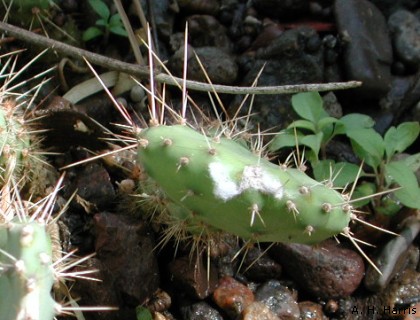

Prickly pears are common throughout the Chihuahuan Desert and Southwest. Many of the cactus pads have patches that, at first glance, look like white fungal growths, but actually are of wax secreted by a tiny scale insect, the cochineal. If you press the insect between your fingers, a scarlet juice squirts out.
This pigmented liquid is a source of an excellent pink or red dye used
for centuries in the Southwest, Mexico, and farther south. Cochineal and dyes derived
from native plants were used by the Hopi and others to dye cotton cloth. When the
Spanish introduced sheep to the American Southwest, the Navajo and Pueblo peoples,
already skilled at weaving cotton, became excellent weavers of wool. At first, their
wool blankets made use of the natural colors of the wool and used only a few dyes.
Later they used yellow from rabbitbrush, black from sumac leaves and piñon sap,
and yellow ocher, an iron mineral. Tragically, the beautiful blankets and rugs became
so popular that the Spanish forced Southwestern weavers into slavery to mass produce
blankets for trade.

Contributor: Elaine Hampton, Associate Professor, College of Education, University of Texas at El Paso.
Desert Diary is a joint production of the Centennial Museum and KTEP National Public Radio at the University of Texas at El Paso.

Prickly pear plant with the telltale white patches. Photograph by A.H. Harris.